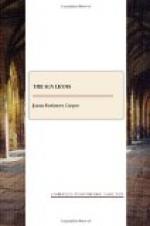Now, the first thing that the student is to fix in his mind, in order to comprehend the phenomenon of the seasons, is the leading fact that the earth does not change its attitude in space, if we may so express it, when it changes its position. If the axis were perpendicular to the plane of the orbit, this circumstance would not affect the temperature, as the simplest experiment will show. Putting the equator of a globe on the outer edge of the table, and holding it perfectly upright, causing it to turn on its axis as it passes round the circle, it would be found that the light from the centre of the table would illumine just one half of the globe, at all times and in all positions, cutting the two poles. Did this movement correspond with that of nature, the days and nights would be always of the same length, and there would be no changes of the seasons, the warmest weather being nearest to the equator, and the cold increasing as the poles were approached. No where, however, would the cold be so intense as it now is, nor would the heat be as great as at present, except at or quite near to the equator. The first fact would be owing to the regular return of the sun, once in twenty-four hours; the last to the oblique manner in which its rays struck this orb, in all places but near its centre.
But the globe ought not to be made to move around the table with its axis perpendicular to its surface, or to the “plane of the earth’s orbit.” In point of fact, the earth is inclined to this plane, and the globe should be placed at a corresponding inclination. Let the globe be brought to the edge of the table, at its south side, and with its upper or north pole inclining to the sun, and then commence the circuit, taking care always to keep this north pole of the globe pointing in the same direction, or to keep the globe itself in what we have termed a fixed attitude. As one half of the globe must always be in light, and the other half in darkness, this inclination from the perpendicular will bring the circle of light some distance beyond the north pole, when the globe is due-south from the light, and will leave an equal space around the opposite pole without any light at all, or any light directly received. Now it is that what we have termed the fixed attitude of the globe begins to tell. If the north pole inclined towards the orbit facing the rim of the table, the light would still cut the poles, the days and nights would still be equal, and there would be no changes in the seasons, though there would be a rival revolution of the globe, by causing it to turn once a year, shifting the poles end for end. The inclination being to the surface of the table, or to the plane of the orbit, the phenomena that are known to exist are a consequence. Thus it is, that the change in the seasons is as much owing to the fixed attitude of the earth in space, as we have chosen to term its polar directions, as to the inclination of its axis. Neither would produce the phenomena without the assistance of the other, as our experiment with the table will show.




